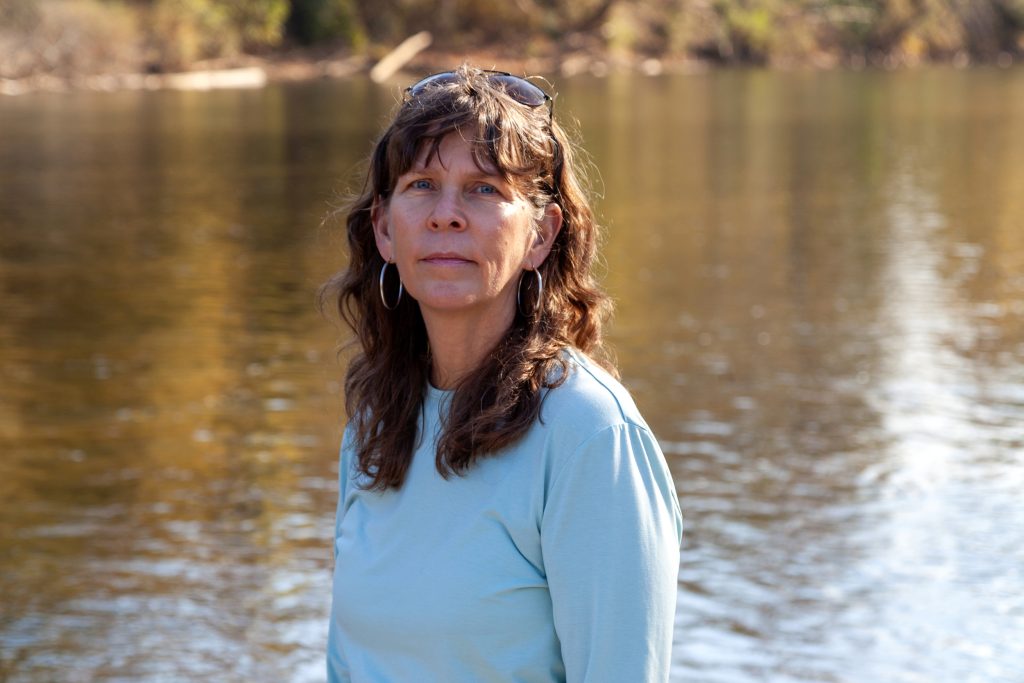Gaslighting: Third in a series about opposition to new natural gas pipelines, power plants, and storage facilities in North Carolina.
EDEN, N.C.—A man was spotted in a white unmarked truck near a natural gas pipeline at the Dan River. This scene mirrored one from the previous month.
Shelley Robbins, senior decarbonization manager for the Southern Alliance for Clean Energy, observed the area while walking towards Draper Landing, a public boat launch and tourist spot.
October saw the landscape transform, with leaves turning russet and saffron. Survey stakes marked “wetlands” were visible. The air was filled with the smell of decay, and vultures circled above.
This river was heavily polluted in February 2014 by toxic coal ash from Duke Energy’s Dan River Steam Plant. Over time, some of this material settled at the river’s bottom despite cleanup efforts.
Fossil fuels are again central to the river’s future. Robbins followed pipeline maps indicating a significant natural gas expansion in North Carolina.
Projects like pipelines and compressor stations are expected to emit methane, a significant greenhouse gas, and other pollutants. These raise concerns about safety and health impacts.
Transco’s pipeline already crosses the Dan River at Draper Landing, with plans to extend further in North Carolina.
The Mountain Valley Pipeline’s Southgate extension, along with the T15 Reliability Project, is planned in this area.
The T15, an existing 63-year-old pipeline, runs through Rockingham and Caswell counties. Due to its age, an upgrade is necessary, with new sections planned through Person County, where Duke Energy intends to build natural gas plants.
A new compressor station, Ruffin II, is planned due to the pipeline upgrade, highlighting the need for larger infrastructure to manage increased pressure.
Previously owned by Public Service Co. of North Carolina, the T15 is now under Canadian energy giant Enbridge following a $4 billion acquisition approved by the N.C. Utilities Commission.
The natural gas for these projects originates from fracking in Appalachia or Gulf Coast plants, destined for homes, businesses, and new Duke plants. Utilities could also resell gas, potentially exporting it.
The complexity and rapid development of these projects are daunting, akin to assembling a puzzle without a clear picture.
Expansion parts are fragmented, subject to varying regulations. The T15, operating solely within North Carolina, bypasses several federal oversight requirements.
“It’s disheartening,” Robbins remarked. “We’re locking in significant risks.”
Robbins’ journey along the pipeline route allowed her to escape conference rooms and presentations. During her trip, she noted Transco’s metering station, a system most locals might overlook.
She noticed the picturesque field and forest by the river but was acutely aware of the pipeline infrastructure.
Robbins documented her observations before leaving the area.
July’s Hearing on the Enbridge Sale
In July, about 20 people gathered for a hearing at the N.C. Utilities Commission in Raleigh. Half were there to testify against Dominion’s plan to sell its subsidiary to Enbridge.
Approval from the Utilities Commission was necessary for Enbridge to become North America’s largest natural gas utility. However, concerns were raised about Enbridge’s safety record.
Despite concerns, the commission approved the sale, transferring all Dominion’s North Carolina infrastructure to Enbridge.
The Ruffin Compressor Station
As Robbins traveled along the pipeline route, she observed several solar farms. She envisions a future powered by solar and battery storage, reducing reliance on polluting infrastructure.
Robbins emphasized the importance of offering alternatives to fossil fuels.
At the Ruffin compressor station, Robbins noted its small size and quiet presence, knowing the new larger station would significantly increase pollution emissions.
The new Ruffin II compressor station will emit more pollutants, posing health risks such as respiratory issues from high ozone levels and carcinogens like benzene and formaldehyde.
Robbins maintained her vigilance over environmental safety concerns, taking photographs for documentation.
At the End, the T15’s Eight-Mile Dogleg
The final segment of Robbins’ route took her through Caswell County, where the pipeline would cross state hunting and fishing lands and skirt the Dan River Work Farm.
In Person County, a new pipeline segment would supply Duke Energy’s proposed gas plants at Hyco Lake.
Robbins was shocked by the proximity of Duke’s plants to Woodland Elementary School, raising concerns about pollution exposure for students.
Emissions from the new gas-fired plants will continue to expose the community to pollutants, albeit at reduced levels compared to coal.
Robbins’ advocacy underscores the environmental and health implications of expanding fossil fuel infrastructure.
Original Story at insideclimatenews.org
